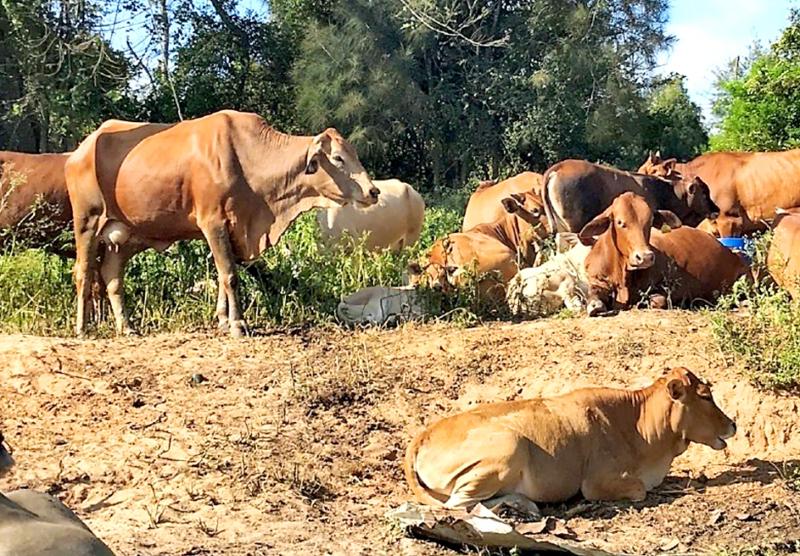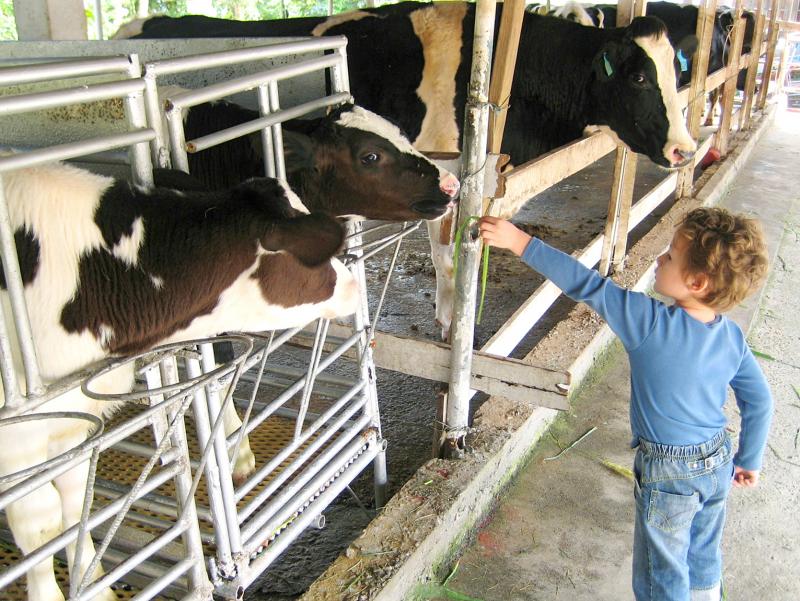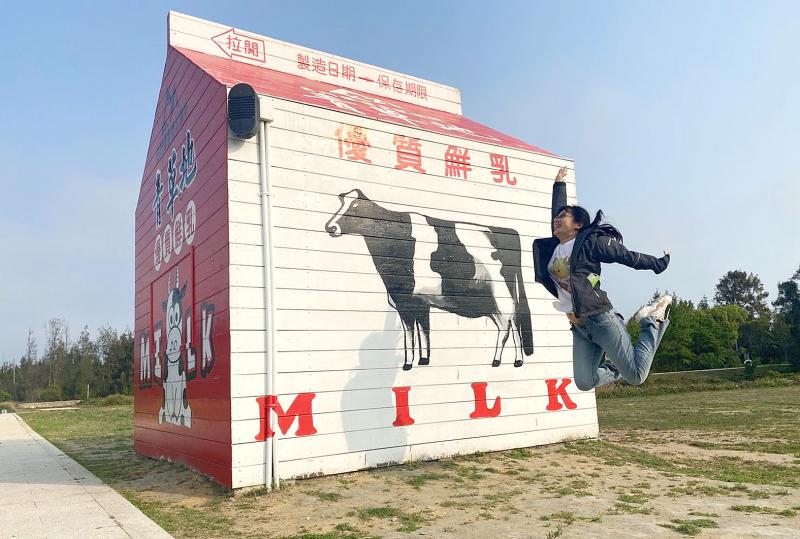The challenge came over a mug of coffee. If I was serious about reducing my environmental impact, a friend teased, I should be putting soy milk, not cow’s milk, in my drink.
Back in February 2016, EcoWatch.com told its readers that cow’s milk represents “60 to 70 percent of the carbon footprint of a cup of coffee with a few tablespoons of milk.”
For a latte, the article said, “it’s more like 80 or 90 percent.”

Photo: Yang Yuan-ting, Taipei Times
My response to my friend ran to two words: “Food miles.” Most of the soy consumed in Taiwan is grown on the other side of the Pacific, I pointed out, whereas almost all of the cow’s milk sold in fluid form in Taiwan’s supermarkets comes from local dairy herds.
“But what do those cows eat, and where does it come from?” he asked.
We both knew the answer. Dairy cows don’t, as some people imagine, subsist on grass. Instead, the 20 to 25kg of food each animal consumes per day comprises roughly equal quantities of forage (grass, hay and silage) and grains (usually corn and soy). Food-processing by-products like cottonseeds, citrus pulp, almond hulls and soy hulls are often added, as are spent grains from breweries.

Photo: Steven Crook
TAIWAN’S DAIRY FOOTPRINT
Just how much of the diet of Taiwanese cattle is imported may surprise you. According to the 2019 Taiwan Grain and Feed Annual, published by the USDA Foreign Agricultural Service, locally grown corn accounted for less 2 percent of all corn consumed in Taiwan the previous year. Nine-tenths of the corn shipped that year to Taiwan (the US and Brazil are the no. 1 and no. 2 suppliers) was fed to poultry and swine.
For soy, Taiwan is even more dependent on imports. Notwithstanding the government’s efforts to boost local soy production (to help solve the problem of rice overproduction, rather than reduce imports), Taiwanese farmers aren’t close to meeting half of 1 percent of domestic demand.

Photo: Wu Cheng-ting, Taipei Times
Because Taiwan is so densely populated, cows here don’t get to do much grazing. Taiwan is one of the top six importers of US hay, and also buys considerable amounts from Australia.
Environmentalists point to other problems associated with cattle farming. Depending on the animal’s size and what it eats, a domesticated bovine may belch 100kg of methane into the atmosphere per year. While methane isn’t as persistent as carbon dioxide, atom for atom it’s a far more potent cause of global warming.
Dairy production consumes a lot of electricity, and not just to refrigerate the milk. Holsteins were bred for conditions in Europe and North America, so dairy farms in Taiwan have to be equipped with heat abatement systems such as enormous fans.
According to the Web site of the Dairy Association of the Republic of China, each lactating cow produces an average (and impressive) 7,000 liters of milk per year. It would therefore be shocking if the animals didn’t drink a huge amount of water, on top of the huge input of food.
I’ve not been able to find Taiwan specific figures, but a Michigan State University Web page says a milking cow typically consumes 113 to 189 liters of water each day, and — this is very relevant to Taiwan — “During periods of heat stress, water intake may double.”
In other words, a farmer must provide each cow with at least six liters of water for every liter of milk he gets. For a country that often suffers water shortages, this looks like a bad deal. To be fair, if you’ve spent any time around cattle, you may have noticed that they urinate frequently and in quantity; at least some of the water goes right back into the land. Also, many of Taiwan’s 550-odd dairy farms are located in the eastern countries of Hualien and Taitung, where the water issue isn’t so acute.
But if you take into account the water needed to grow and transport what’s fed to the cow, and to package the milk, it becomes clear that the industry consumes a massive amount of water.
A 2011 report published by UNESCO’s Institute for Water Education concluded that the per liter water footprint of cow’s milk varied from 540 liters (in the case of milk produced in the UK) to 1,800 liters (for Spanish milk), the global average being 1,050 liters. The same report calculated that the water footprint of a liter of soy milk produced in Belgium totaled 297 liters.
Proponents of soy like to point out that it’s a legume, like peas, lentils and peanuts. While growing, it therefore takes nitrogen from the air and puts it back into the soil. Nitrogen is a key nutrient for plants, and farmers who grow soy in rotation with other crops have found they needn’t apply so much artificial fertilizer.
SAUCY SOY
Now for some bad news about soy.
First, as mentioned above, almost all of the soy that becomes tofu, soymilk or another product for human or animal consumption travels over 10,000km before it reaches a human or non-human mouth in Taiwan, even though the actual grinding into milk (or crushing for oil) is done locally.
Second, clearing land so soy can be grown is said to be a major cause of deforestation in Brazil.
Those who argue the Taiwanese diet was colonized by the US after World War II highlight the history of soy products on the island.
Before the 1895 Japanese takeover, local farmers grew black soybeans for making soy sauce.
What little soybean oil was produced was burned in lamps, or blended with more popular cooking oils, such as peanut or rapeseed oil.
By the early 1970s, however, the American Soybean Association had realized that its customers in Taiwan — who focused on crushing imported yellow soybeans into meal to feed to pigs and chickens — were awash in surplus oil.
In what seems to have been a case of conjuring demand for an unpopular commodity, rather than introducing a product that could meet an existing demand, the association worked to improve the quality of soybean oil, and promoted it heavily through TV and radio.
Despite old folks complaining that cooking with soybean oil made their stoves not merely greasy, but actually so sticky that only strong detergents could remove the glue-like gunk, the low price of soybean oil has ensured its popularity ever since.
RICE MILK
Soy and dairy aren’t the only beverage options. If food miles are your main concern, rice milk could be a good choice, as Taiwan produces almost all the rice it needs, and rice milks are widely available.
According to an article on Earth911.com in August last year, the carbon footprint of rice milk is somewhat higher than that for milks made from soy, almonds or oats. Yet, liter for liter, it’s responsible for barely a third of the carbon emissions generated by cow’s milk.
Unlike the stuff that comes out of a cow, unfortified rice milk lacks useful amounts of calcium or protein, even though it has a much higher proportion of carbohydrates. Soymilk bottlers also add calcium and vitamins to make up for its deficiencies compared to cow’s milk.
Taiwan is one of the few countries in which you can have fresh, pasteurized goat’s milk delivered to your home. However, an article on Brightly.eco in September last year concluded that goat’s milk “is not significantly better for the environment than cow’s milk [even though goat farming] requires less water and land than cattle farming, and they produce less manure.”
I’m not sure if I trust this assessment, because the writer seemed to regard manure as a waste product and not as a valuable asset.
Some time soon, I’ll try goat’s milk in my morning pick-me-up. Until then: Anyone for black coffee?
Steven Crook, the author or co-author of four books about Taiwan, has been following environmental issues since he arrived in the country in 1991. He drives a hybrid and carries his own chopsticks.

“Why does Taiwan identity decline?”a group of researchers lead by University of Nevada political scientist Austin Wang (王宏恩) asked in a recent paper. After all, it is not difficult to explain the rise in Taiwanese identity after the early 1990s. But no model predicted its decline during the 2016-2018 period, they say. After testing various alternative explanations, Wang et al argue that the fall-off in Taiwanese identity during that period is related to voter hedging based on the performance of the Democratic Progressive Party (DPP). Since the DPP is perceived as the guardian of Taiwan identity, when it performs well,

The Taiwan People’s Party (TPP) on May 18 held a rally in Taichung to mark the anniversary of President William Lai’s (賴清德) inauguration on May 20. The title of the rally could be loosely translated to “May 18 recall fraudulent goods” (518退貨ㄌㄨㄚˋ!). Unlike in English, where the terms are the same, “recall” (退貨) in this context refers to product recalls due to damaged, defective or fraudulent merchandise, not the political recalls (罷免) currently dominating the headlines. I attended the rally to determine if the impression was correct that the TPP under party Chairman Huang Kuo-Chang (黃國昌) had little of a

At Computex 2025, Nvidia CEO Jensen Huang (黃仁勳) urged the government to subsidize AI. “All schools in Taiwan must integrate AI into their curricula,” he declared. A few months earlier, he said, “If I were a student today, I’d immediately start using tools like ChatGPT, Gemini Pro and Grok to learn, write and accelerate my thinking.” Huang sees the AI-bullet train leaving the station. And as one of its drivers, he’s worried about youth not getting on board — bad for their careers, and bad for his workforce. As a semiconductor supply-chain powerhouse and AI hub wannabe, Taiwan is seeing

Jade Mountain (玉山) — Taiwan’s highest peak — is the ultimate goal for those attempting a through-hike of the Mountains to Sea National Greenway (山海圳國家綠道), and that’s precisely where we’re headed in this final installment of a quartet of articles covering the Greenway. Picking up the trail at the Tsou tribal villages of Dabang and Tefuye, it’s worth stocking up on provisions before setting off, since — aside from the scant offerings available on the mountain’s Dongpu Lodge (東埔山莊) and Paiyun Lodge’s (排雲山莊) meal service — there’s nowhere to get food from here on out. TEFUYE HISTORIC TRAIL The journey recommences with